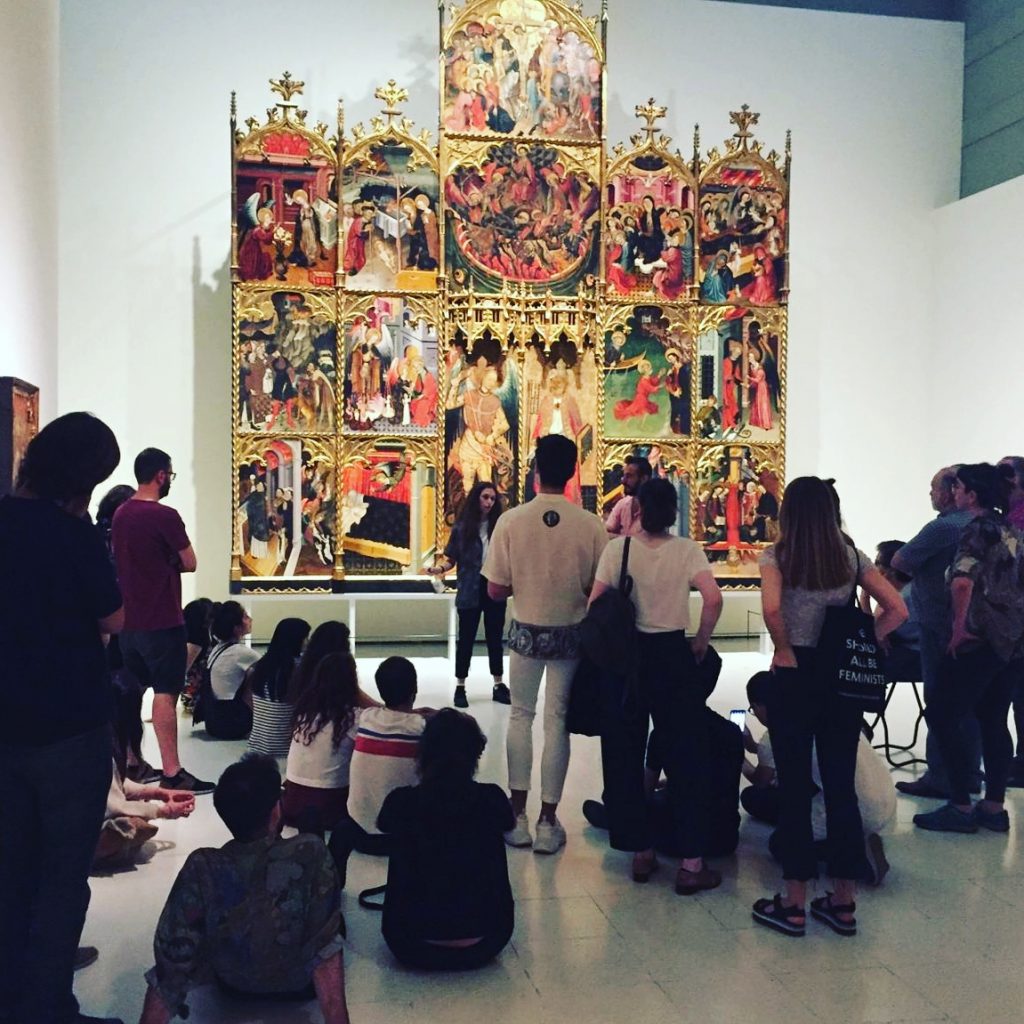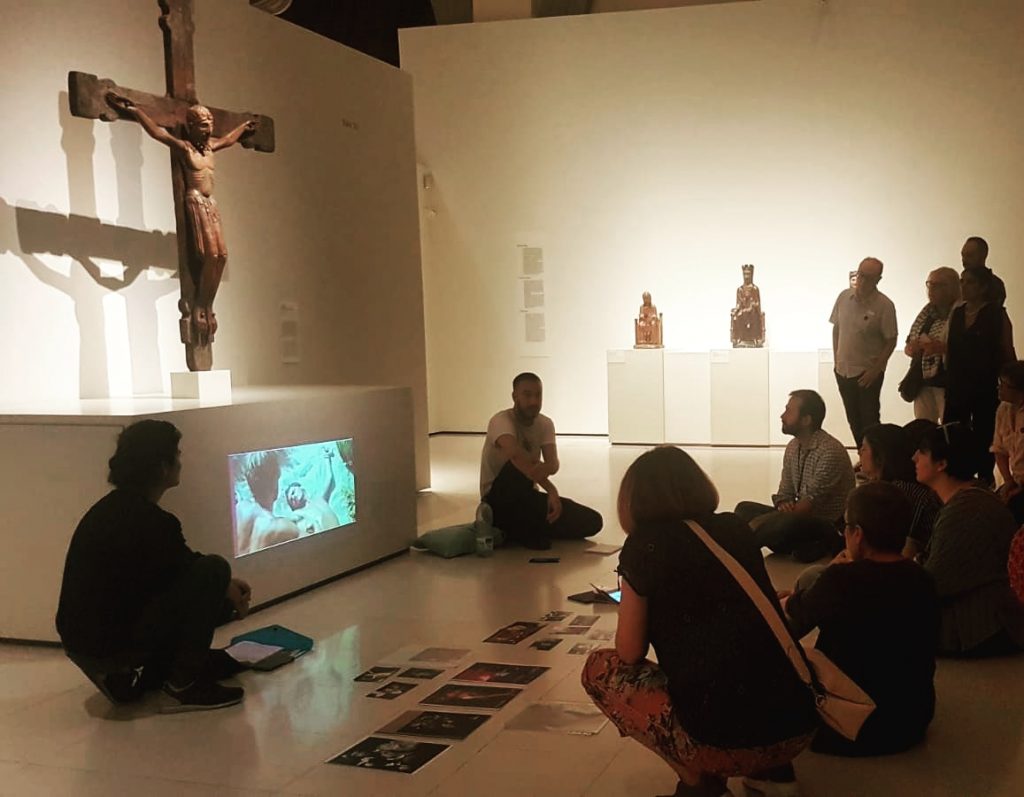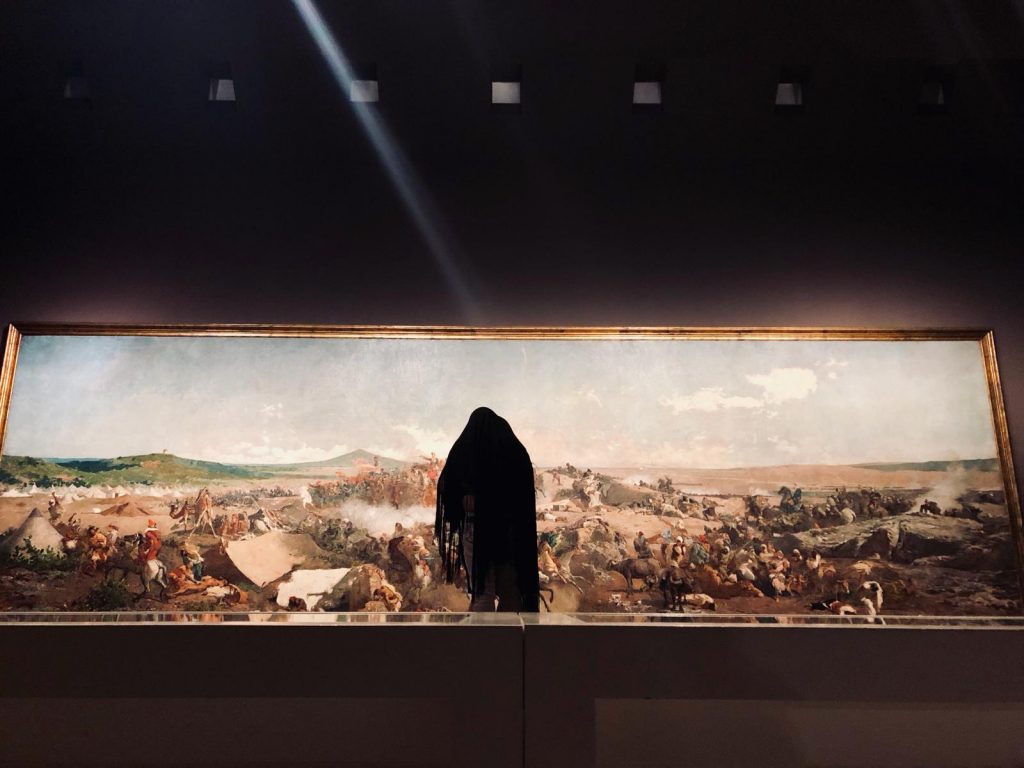Víctor Ramírez Tur
Intersexualities with Maria Gómez
On the first rebellious visit in June we were accompanied by Maria Gómez, activist and researcher specializing in intersexualities. For those for whom the “I” of the LGBTI initials is the great unknown, we should remember that, despite the character’s escape from its definition, we could define intersexualities as those natural physiological possibilities in which the relationship between chromosomal sex, The hormonal process, the internal and/or external genitalia and the physical appearance do not fit the binary and normative classification that divides us strictly in men and women. As you can imagine, this physiological possibility appears underrepresented throughout history and not only from an artistic perspective. Therefore, the question that arises from us is what sort of rebellious view we can cultivate in the museum linked to these experiences.
In a conversation prior to the visit with Mary, we can observe how, surely, the iconography used most in the history of art to elaborate intersexual experiences is that of the hermaphrodite. However, it is not the only one, and it would be rather difficult to find in the collection of the Museu Nacional, which is not very pagan. And this is where Angelic iconography appears as a visual field in which the sexual representation becomes ambiguous. Obviously it could not be otherwise, because the sex of the angels is an entelechy and, as Louis Réau explains in his Iconography of Christian art, the representation of the angels, like that of the Trinity, has always caused headaches for creators in order to be able to resolve their representation. Réau mentions, as some of the causes of this difficulty, the inaccuracy of the accounts of the Bible and the fact that the angels are described as pure spirits, as inconsistent presences which are practically invisible.
Nevertheless, in this case, the obstacle is transformed into power. As, when it comes to representing the sex of the angels, Réau classifies, the typology of the young angels coexist and are mixed as a beautiful and blond teenager with blond hair, women angels and children angels. And precisely, with a quick stroll through the gothic art rooms of the museum collection, we could observe this ambiguity of gender with which this iconography has been represented. This is what we do, for example, when stopping at the Altarpiece of Archangel Saint Michael attributed to Joan Mates – the first quarter of the 14th century – or the Altarpiece of Saint Michael and Saint Peter by Jaume Cirera and Bernat Despuig – 1432-1433. Precisely in front of this piece, the activist and researcher specializing in intersexualities decided to stop to share with attendees of this first visit, not only this possibility of intersexual people to find iconographic alliances with the representation of angels, but especially with that of black angels.
The altarpiece represents well-known episodes with an angelical presence such as the triumph of the Archangel Saint Michael leading the battle against rebel angels, the same saint weighing souls or Saint Peter being released from prison of Rome by an angel. Above the two central figures, the fall of the rebel angels appears, establishing a clear difference between young angels and those who have not respected the divine authority, transforming themselves in their fall into hell into monstrous black angels. Maria is especially interested in this predella and shares a case of specific identification in adolescence with the figure of the black angel. The rebellious view is not established here, therefore, with the identification with the angel, but with that of the fallen angel, thus establishing a parallelism between the one who dared to confront the divine authority and the existence of a corporality that defies the hegemonic modes that impose a single binary definition of sex and gender. In this way, the appropriation of angelical iconography from a rebellious intersexual view not only allowed making the “I” of the LGBTIs less invisible and unknown, but also to take sides and celebrate with pride the rebellion of the black angels.

Leaving the angels to one side, or rescuing the one that whispered in the ear of San Sebastián de Mates, we have opened up the second way that was derived from the Christian Apollo. We refer here to the ties between certain Christian iconographies and homosexual experiences, many of them linked to the outbreak of AIDS from the end of the eighties onwards, of the twentieth century. And, after a return to a more pathetic San Sebastián, tormented and aged in Baroque plastic art, Bernini, Reni, in the nineteenth and especially the twentieth centuries, they will rescue, now explicitly, a saint who is sexualized and delivered to homoerotism. In this sense we could incorporate multiple photographs of the couple formed by Pierre et Gilles, but we prefer to mention the pieces by David Wojnarowicz and Derek Jarman.
In one of the scenes of the first film of the English filmmaker, Sebastiane -1976-, the saint appears on the ground with a stance that inevitably refers to the crucifixion of Jesus Christ. Jarman recuperates in this way the connections that throughout the history of art have been established between the ordeal of the son of God and the saint martyred during the persecution of Diocletian. In fact, this link is confirmed in the museum’s own collection with the pieces by Ferrer and Mates mentioned above. However, we choose the pedestal of Christ from 1147 – anonymous, consecrated in 1147 – and that of the Batlló Majesty – anonymous, mid-seventeenth century – to develop this dialogue; and if we do so, it is because a group of 20th century creators compared the ordeal lived by Christ with the one lived by being homosexual or seropositive.

The iconography of the passion with an LGBTI viewpoint
To develop this last sequence of rebellious views around the iconography of the Passion, we would be accompanied on different days by Nancy Garín, Aimar Pérez and Jaime Conde-Salazar. The reasons for this selection could be multiple, but are mainly justified by the Anarxiu Sida project, developed by the researcher together with the Team Re around the link between visuality and HIV/AIDS in Latin America and the Spanish State; and for the multiple materials derived from the work, The Touching Community, in which Aimar, in collaboration with Jaime and other people, have investigated the relationship between the outbreak of AIDS and contact dance, also in Spanish-speaking countries. Thus, taking as a reference the two above-mentioned Romanesque sculptures where it is confirmed to us, not only the richness of the museum wood sculpture collection, but also the presence of the “Majesty” as one of the most developed types in Catalonia during this period, where we cultivate a new constellation of rebellious views. Because, both the marks of martyrdom lived as the symbolism of the triumph over death incarnated in the two sculptures mentioned, serve to observe how these contents linked to this iconography have been cited by those homosexuals who would live the crude beginning of the outbreak of AIDS. Remembering here some examples that include, for example, the painting by Derek Jarman from his series, Smashing Times, where a crucifix with a pot of lubricant, a condom with blood remains and the word “AIDS”, or all those actions by Latin American artists that Nancy spoke to us about, where in many cases the issue of AIDS was accompanied by repressive dictatorial contexts, such as Pedro Lemebel, Francisco Copello, Guillermo Moscoso or the Yeguas del Apocalipsis.
In order to enlarge this last dialogue we move to another of the predominant sculptural typologies in the Catalan Romanesque: the descent from the cross. And we obviously embrace it with the masterful set of the Figures of the Descent from the Cross from Santa Maria de Taüll– second half of the 12th – 13th century. In this case, we establish the dialogue based on two interlinked axes. On the one hand, the theatrical use of these figures in the liturgical celebrations allows us to recover a set of contemporary performative proposals where the gesture of curing and supporting a sick or dead body of iconography and the Somateca of the descent from the cross. Thus, thanks to the company of Nancy, Aimar and Jaime we put together the gesture of Maria and Josep d’Arimatea holding the body of Christ with the action Carrying -1992- by Pepe Espaliú, one of the graffiti of Keith Haring and some fragments of the dance piece, The touching community by Aimar Pérez, where similar gestures appear. If the figure of Christ in the set of Taüll includes Joseph’s hand carved in his own body and therefore, stuck forever for the caring and the tenderness of sustaining, Espaliú, Haring and Pérez Galí resume that community of the affectionate touch that it had to generate to support, embrace and help those people affected by the disease.
Furthermore, we decided to zoom in on the wound of Christ, both from the carnal hole of the wooden piece and from the scene where the Roman soldiers produce the wound of Sorpe’s set of paintings –mid 12th century, which also dialogue in the rooms of the museum with the aforementioned descent. And we do so, first of all, from the dialogue with the action El tajo (The cut) -1996- by Águeda Bañón, where the artist, after producing an incision on the collarbone, licks with the desire to nourish herself and establish an affirmative relationship with her own fluids affected by the virus. And secondly with the film, Carvaggio -1886- which Jarman produced in the year he found out that he also carried the virus. This film reproduces in a heterodox way the narrative and the work of the Baroque painter around the incredulity of Saint Thomas. This scene, as well as the commentaries that Peggy Phelan dedicated to him in her essay, Morning Sex: public performing memoirs inspired Aimar and Jaime for their participation in these rebellious views. The two creators remained with their eyes closed during the whole visit, which forced the attendees to take care of their presence, helping them and accompanying them throughout the tour. At the end of the visit, in the room presided over by The battle of Tetuan -Maria Fortuny, 1863-1865, Aimar and Jaime established a dialogue based on the text of Phelan, in which they talk about the need for touching, as a proof of love. In fact, the artists ended up leaning on the bench prepared to contemplate the warlike painting, hidden under the black veil of one of them and accompanied by the song of Nina Simone Wild is the Wind. In this way, the contents of religious roots or, in this case, colonial, of a considerable collection of pieces of the museum, were transformed into a Somateca that invited dissident sensuality, to the reaffirmation of non-normative identities and to generate the community of the brave, sustained and tender touch.
Love me, love me, love me, say you do. Let me fly away with you. For my love is like the wind. And wild is the wind.

Related links
Rebellious views: readings from the collection from an LGBTI viewpoint
Víctor Ramírez Tur







